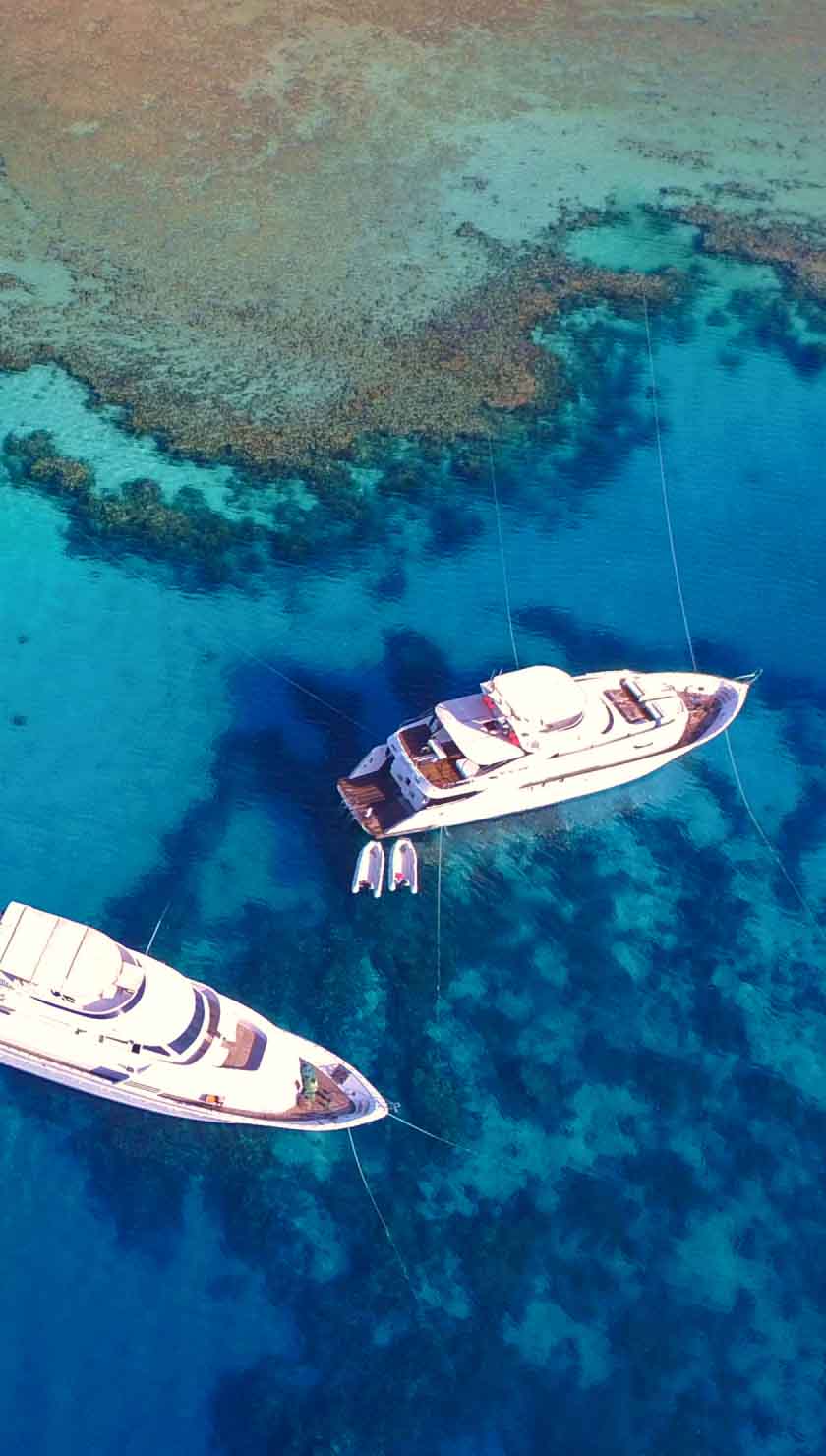The length of most liveaboard itineraries to Ari Atoll ranges from 7 to 12 nights. The best time to dive in Aril Atoll is the calm-sea season of December to May. The water temperature usually remains between 26-29 C, and visibility is at 15-20 meters. Budgets for liveaboards in Ari Atoll range between 200 to 400 euros per. day. Ari Atoll liveaboards depart from Male, reachable by short flights from nearby Singapore, Dubai, and Colombo, as well as longer flights worldwide. Places to dive in and around Ari Atoll are North and South Male Atolls, Rasdhoo Atoll, and sometimes Baa Atoll. Ari Atoll's liveaboard itineraries will often include a combination of the above.
Baa Atoll, in the Maldives' Northern Atolls area, offers an array of famously beautiful underwater landscapes and plentiful marine life. At Maavaru Kandu, you can dive below huge rocky overhangs festooned with luminous pastel gardens of blue, yellow, and green soft corals. Dhonfanu Thila and Dhigali Haa dive sites are underwater pinnacles known for their scenic whip corals, bushy black corals, and sea fans, as well as schools of snapper and regular manta rays. Hanifaru Bay even enjoys world-famous manta and whale shark aggregations during the plankton-rich months from August through November. Some diving in Baa Atoll is suitable for beginners with moderate currents. Liveaboards in Baa Atoll are mostly MV yachts and luxury yachts.
Nilandhe Atoll, on the western border of the Maldives' Southern Atolls, is a great destination for liveaboard diving. It comprises two atolls - the northern atoll is known for its big schools of fish, sharks, Napoleon wrasse, and eagle rays. The southern atoll is home to an abundance of protected areas teeming with marine life, including grey reef sharks, schools of fusiliers, snappers, sweetlips, and even tuna, turtles, and mantas. No matter your interests, Nilandhe Atoll will surely have something for you.
Fuvahmulah, in the southernmost atoll of the Maldives, offers an unparalleled diving experience. Diving into the crystal-clear waters teeming with vibrant coral reefs, exotic marine life, and the chance to spot elusive species like tiger sharks and oceanic manta rays. Fuvahmulah's most popular dive sites include Gahaa Kandu and Thoondu Point; schools of colorful fish and vibrant coral formations often surround divers.
The length of most liveaboard dive cruise itineraries to Baa Atoll ranges from 7 to 10 nights. Baa Atoll dive sites can be visited year-round, though the southwest monsoon from May to November can make the seas a bit choppy. The water temperature stays stable at 27-30 C. Budgets for Baa Atoll liveaboards range from 200 to 400 euros per day. Many liveaboards bound for Baa Atoll depart from Male. However, some depart from Hanimadhoo in the north and spend their whole itinerary in that area. Hanimadhoo can be reached by domestic seaplane from Male. Some itineraries on a Baa Atoll-bound liveaboard include North Male and Ari Atoll. Other itineraries may spend more time among Baa's uncrowded neighbors in the north: Lhaviyani, Noonu, and Raa Atolls.
Longer dive safaris include Lhaviyani, Felidhoo, Vaavu, and Meemu atolls, whilst, during January-March, several Maldives dive liveaboards focus their attention on Huvadhoo Atoll in the Deep South close to the Equator. No matter which dive trip you choose, you can be sure to see healthy corals surrounded by colorful reef fish and plenty of pelagic fish action on every dive.
More about the Atolls of Maldives
- Jump off the plane and hop on a boat for a classic Maldives dive trip in the Central Atolls.
- Grab your bunk on an exclusive Far North Atolls liveaboard for untouched, pristine diving.
- Drift dive the Southern Atolls in serenity and witness Maldives' marine life with exceptional visibility.
- Crack the Maldives' best-kept secret- tiger sharks and oceanic whitetips in the Deep South.
Tips for Travellers
The best time to dive in the Maldives is all year. However, some people prefer to avoid monsoon season, which hits the area in April and continues to rain through October. The water temperature typically ranges between 26 to 30 degrees Celsius (80 to 86 degrees Fahrenheit), with visibility from 20 meters (65 feet) to as far as the eye can see. Water depths include shallow reefs, deep walls, and everything in between, ensuring every diver can find their perfect dive. For the more intrepid diver, there are slow currents in many areas, and extremely strong currents jetting through the atoll pass for the more experienced thrill seeker. Whatever your tastes, Maldives has the diving suited just for you, which can be enjoyed in mild outside weather ranging from 24 to 33 degrees Celsius (75 to 91 degrees Fahrenheit).
In the Maldives, additional liveaboards fees usually include gear rental (not covered by your trip price), which can be in the vicinity of 40 USD per person per night. Every diver must also independently purchase dive insurance before getting in the water. Some other fees like extra alcoholic drinks and special gear such as torches may incur additional charges. In the Maldives, a new Green Tax of 12 USD per person per night applies for every tourist in the country. Some islands and marine parks have national park fees that are not included in liveaboard packages, like Hanifaru Bay's park entrance fee of 20 USD per person. Nitrox is offered on virtually every Maldives liveaboard- some as a complimentary service, and some for a fee. Depending on the route, a fuel surcharge per person per night may be added. This surcharge usually ranges from 10 to 15 USD per night. If you have any questions about extra fees in the Maldives, don't hesitate to contact us directly. We are here for you.
Minimum logged dives are required by many Maldives diving liveaboards, Scubaspa Yang and Ying being the exceptions. Ocean Divine requires 20, MV Orion and Amba require 50, and Carpe Vita requires 100. Safety briefings on boats like Scubaspa Yang and Ying are conducted on day one. Check dives on liveaboards in Maldives are often held in Male on the first day.
The official language of the Maldives is Maldivian or Dhivehi.
A free 30 day visa is issued on arrival to all tourists in the Maldives. However, tourists must possess a valid passport, a valid outbound ticket and either a reservation confirmation in a hotel or enough funds to cover expenses for the duration of their stay (30 USD per. day).
There are no compulsory vaccinations for travel to the Maldives unless you have been in a country with increased yellow fever risk sometime in the nine days previous to arrival. In such cases, you must have proof of a yellow fever vaccination. We recommend standard protection against tetanus, diphtheria, pertussis, polio, influenza, typhoid and hepatitis A. There is no endemic malaria risk in the Maldives. However, the rainy season (May through September) elevates the risk of dengue fever. For advice on Malaria and Dengue, seek professional medical advice before travelling.
Electricity voltage runs at 220-240 volts; the standard socket is UK-style three-pin, but many resorts have universal sockets to accommodate non-UK tourists.
The Maldives is the smallest Asian country by land area (300 square kilometres) and population, but its underwater offerings are comparatively huge- 90,000 square kilometres of ocean. Fewer than 300 of its roughly 2000 islands are inhabited, leaving the rest of the white-sand paradises to sharks and corals, and the lucky divers who visit them. At a maximum height of about 2.5 meters above sea level, the Maldives is at incredibly high risk from global warming, which contributes to its activism for carbon-pollution reduction worldwide. Thirty one protected areas exist in the country, and incredible coral restoration projects are common.
Ports of Departure and how to get there
Male is the main liveaboard departure location in the Maldives, and the country's capital city, located on the southern edge of North Male Atoll (also called Kaafu Atoll). The main Male departure port is Hulhule, next to the Male airport. Liveaboards diving in the Central Atolls set out from here. North Male Atoll is the best known and explored dive area in the Maldives, long recognized as a world-class manta and reef shark destination with many longstanding, beloved dive sites of pinnacles, wrecks, coral gardens, and cleaning stations. Entry level divers can find offerings around Male, even though currents can be strong. Standard liveaboards departing from Male may visit North Male Atoll, Ari Atoll and Rasdhoo Atoll, and sometimes Baa Atoll as well. Other liveaboards may head south of Male Atoll to include Meemu (Malaku), Vaavu (Felidhu), and Thaa (Kolhumadulu) atolls.
Travellers bound for Male can take direct flights from Dubai, Singapore, and Colombo. Longer international flights from Europe, America, China, India, and Australia are all readily available, often connecting through the airports mentioned above. Flights to the Maldives are available on multiple airlines, such as British Airways, Cathay Pacific, Lufthansa, Emirates, Etihad Airways and Singapore Airlines, among others. From the UK, expect at least a 13 hour trip. From Germany or Australia, the flight duration is at least 12 hours. Divers arriving from the USA can fly first to Singapore, with a flight duration of 20 hours from Los Angeles.











